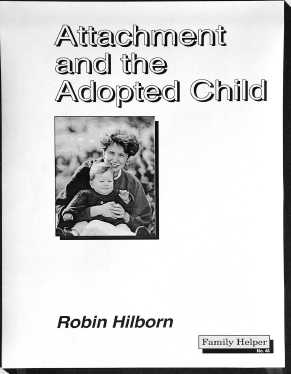
Attachment
and the
Adopted Child
By Robin Hilborn
First edition, 2006
$12 / ISBN 0-9733470-7-4
| Family Helper > Post-adoption > Attachment and the Adopted Child |

|
Attachment and the Adopted Child By Robin Hilborn
|
|
Graefe / Attachment: a core issue Smart / Four stages in the attachment cycle Bayless / Behaviour of the unattached child ADSR / Causes and symptoms Bayless / Needs of the child Flanders / "Dear teacher: I'm not a bad parent" Becker-Weidman / Activities to help attachment Gray / Encourage a strong bond Hopkins-Best / Attachment and toddler adoption Webb / Theraplay for a healthy parent-child relationship Trenberth / Three comforts for the afflicted |
Smart / When it becomes too much to handle Smart / PTSD in parents Gallant / How I became a Therapeutic Mom Smart / Couples need strength Combs / Challenge to your marriage McCreight / Ten ways to survive the tough times Kupecky / Do sibling rights trump attachment? Lametti / Review, "A Child's Journey Through Placement" NAIC / How to find a good adoption therapist Hilborn / Attachment Resources |
Where to go for help? Robin includes a helpful guide on "How to find a good adoption therapist" and a list of attachment therapists in Canada and the U.S.
As Jennifer said in 1998, "With professional counselling, assistance in becoming a 'therapeutic parent' and ongoing support, you have every reason to be hopeful for positive and lasting change in your child's behaviour. Then your family life will become much more enjoyable again, as it was meant to be."
See below for an excerpt from Attachment and the Adopted Child. To order, fill in this form and send with your cheque to: 220 Summerhill Rd., Southampton, Ont. N0H 2L0 Canada.
| Please send me one copy of Attachment and the Adopted Child (#48). |
I enclose a $12 cheque to "Robin Hilborn". Name: Street address:
|
Attachment and the Adopted Child (#48) is also available at a discount ($9) when you order four or more titles from the Family Helper series. See the form at Family Helper, and choose the editions you'd like to order.
Children who are adopted after the age of 6 months or so are at risk for attachment problems. Normal attachment develops during the child's first two years of life. Problems with the parent-child relationship during that time, or breaks in the consistent caregiver-child relationship, prevent normal attachment. The severity of attachment disorder seems to depend on the number of breaks in the bonding cycle and the extent of the child's emotional vulnerability.
Emotional vulnerability can be affected by such factors as: genetic factors; prenatal development including maternal drinking and drug abuse; pre-natal nutrition and stress; Fetal Alcohol Syndrome; temperament; and birth parent history of mental illness (schizophrenia, manic depressive illness, etc.). One thing is certain: if an infant's needs are not met consistently in a loving, nurturing way, attachment will not occur normally.
Touching, rocking, eye contact, movement and physical closeness all will facilitate developmental attachment. Any activity that encourages reciprocity (such as pat-a-cake) and emotional attunement is helpful.
1. Peek-a-boo with hands, blanket, hood of jacket, from behind a door.
2. This little piggy went to market with fingers or toes.
3. Comb the child's hair facing each other while commenting on color, texture, shape, and form.
4. Washing child's face, bathing child.
5. Lullaby singing. Cradle your child so that eye contact is maintained while you gently rock child and sing. Be sure to put child's name and descriptions of the child's features into the song whenever possible.
6. Push that Button. Gently press on the child's nose, ear, finger, toe, chin, etc. and make a noise such as "honk", "beep", or "toot." Then have child copy your actions.
7. Blow raspberries on child's arm, leg, belly, cheek.
8. "Pop" cheeks. Fill your mouth with air and gently guide your child's hands to your cheeks to pop out the air and make a sound. Then do the same to the child.
9. Singing and rhyming couple with movement. Bouncing, dancing, rocking, moving arms or legs, fingers, etc. Simon Says games.
10. Rubbing lotion onto child's hands, feet, arms, or legs.
11. Playing with clay or shaving cream together to make shapes.
12. Tower of hands: alternate hands and then move bottom hand to top of pile.
___________________________________
Dr. Art Becker-Weidman, CSW-R, PhD, DABPS is director of Center for Family Development in Williamsville NY, www.center4familydevelop.com. He may be reached at AWeidman@AWeidman.cnc.net.
How to order Attachment and the Adopted Chld
| Infertility | Adoption | Adoption Resource Central | Post-adoption | Family Tree |
| Contact: Robin Hilborn, helper@familyhelper.net 220 Summerhill Rd., Southampton, Ont. N0H 2L0 Canada |
Copyright 2009 Robin Hilborn. All rights reserved Updated Apr 13, 2009 |
|
Family Helper www.familyhelper.net |
A WEB RESOURCE FOR FAMILIES SINCE 1996 | |||
| About us Copyright Privacy Disclaimer |